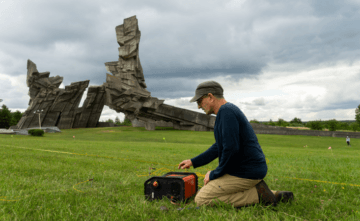Virat Markandeya in Nautilus:
 On a trip to Warsaw, Poland, in 2019, Richard Freund confronted the history of resistance against the Nazis at a Holiday Inn. Freund, an archaeologist, and professor of Jewish Studies at Christopher Newport University in Virginia, was led by the hotel manager into the basement. “Lo and behold,” Freund says, a section of the Warsaw Ghetto wall was visible. Freund was in Warsaw accompanied by scientists from Geoscientists without Borders, a nonprofit group whose mission includes investigating archaeological sites and working to mitigate natural disasters like earthquakes and tsunamis.
On a trip to Warsaw, Poland, in 2019, Richard Freund confronted the history of resistance against the Nazis at a Holiday Inn. Freund, an archaeologist, and professor of Jewish Studies at Christopher Newport University in Virginia, was led by the hotel manager into the basement. “Lo and behold,” Freund says, a section of the Warsaw Ghetto wall was visible. Freund was in Warsaw accompanied by scientists from Geoscientists without Borders, a nonprofit group whose mission includes investigating archaeological sites and working to mitigate natural disasters like earthquakes and tsunamis.
The geoscientists were helping Freund pinpoint the location and contents of underground bunkers, where hundreds of Nazi resisters, led by 24-year-old Mordechai Anielewicz and his girlfriend Mira Fuchrer, plotted to combat the deportation of Jews to death camps. The rebellion erupted in the Warsaw Ghetto Uprising of 1943, the largest Jewish revolt in World War II. The resistance lasted nearly a month. During the battles, Nazis funneled poison gas into the underground bunkers, killing many of the rebels and driving others to escape through sewer tunnels. The Nazis crushed the uprising and razed the Warsaw ghetto. Tens of thousands of Jews either died in the battles, were executed, or were deported to death camps.
The history of the uprising was written in part by those who escaped. “They tell us what happened in that final moment,” says Freund, who has led archaeological investigations into Jewish history in Israel and Europe. But the story of the Warsaw uprising, and the Holocaust, is not complete. Holocaust survivors and their stories are dwindling. Now geoscientists have stepped in to fill in the historical gaps. By employing geophysical mapping and soil sampling, among other techniques, they have located mass grave sites—there are an estimated 200 such sites in Lithuania alone—corroborated testimonies of daring escapes, and unearthed the remains of a once-thriving culture.
More here.
